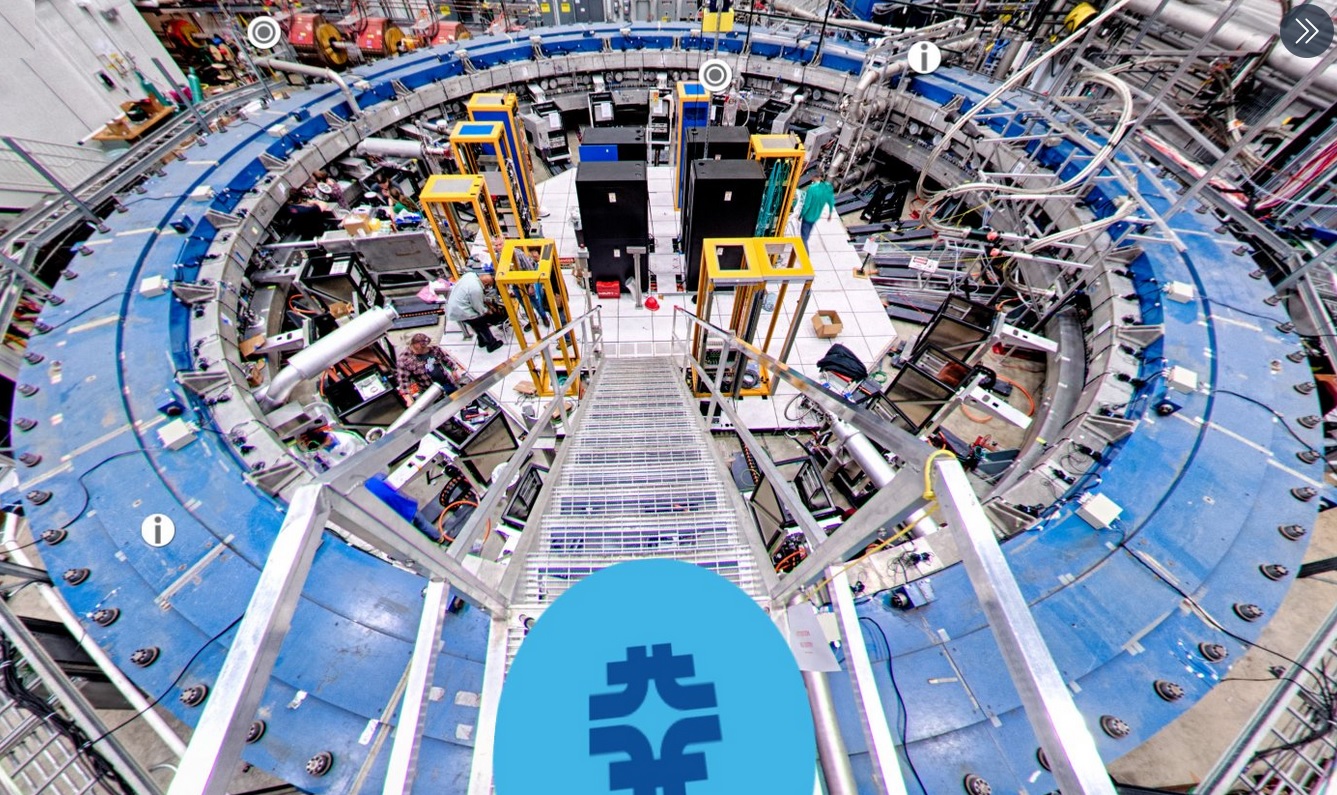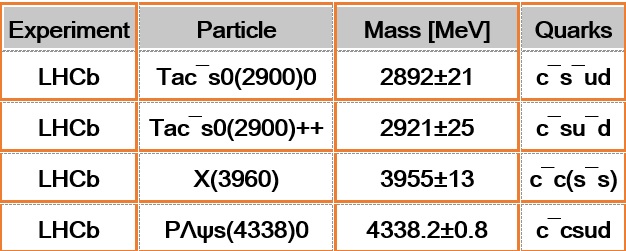Taking a closer look at LHC
On the Home page we present some of the most recent and interesting news on Particle Physics, in our opinion, that have CERN (and the LHC, in particular) as a protagonist.
In this section, you will find news from previous years, which were initially on the Home page. Please note that some of the news items shown here were subsequently confirmed, updated and others discarded.
To follow all the events of interest more closely, you can visit the following websites.
More generally, you can visit the Links section of our website where you will find other links of interest.
An exabyte of disk storage at CERN
September, 2023
CERN disk storage capacity passes the threshold of one million terabytes of disk space
CERN’s data store not only serves LHC physics data, but also the whole spectrum of experiments and services needing online data management.

The first observation of neutrinos at LHC.
August 2023.
While neutrinos are estimated to be some of the most abundant particles in the universe, observing them has so far proved to be highly challenging, as the probability that they will interact with other matter is very low.
Neutrinos are produced very abundantly in proton colliders such as the LHC, however, up to now, these neutrinos had never been directly observed.
The FASER and SND@LHC collaboration are two distinct research efforts, both utilizing the LHC at CERN. Recently, these two efforts independently observed the first collider neutrinos, which could open important new avenues for experimental particle physics research.
ATLAS sets record precision on Higgs boson’s mass.
July 2023.
Taken from CERN Website.
The mass of the Higgs boson is not predicted by the Standard Model and must therefore be determined by experimental measurement. Its value governs the strengths of the interactions of the Higgs boson with the other elementary particles as well as with itself. A precise knowledge of this fundamental parameter is key to accurate theoretical calculations which, in turn, allow physicists to confront their measurements of the Higgs boson’s properties with predictions from the Standard Model. Deviations from these predictions would signal the presence of new or unaccounted-for phenomena.
The new ATLAS measurement combines two results: a new Higgs boson mass measurement based on an analysis of the particle’s decay into two high-energy photons (the “diphoton channel”) and an earlier mass measurement based on a study of its decay into four leptons (the “four-lepton channel”).
The new measurement in the diphoton channel, which combines analyses of the full ATLAS data sets from Runs 1 and 2 of the LHC, resulted in a mass of 125.22 billion electronvolts (GeV) with an uncertainty of only 0.14 GeV (0.09%).
First evidence of the rare decay of the Higgs boson into a Z boson and a photon.
May 2023.
The Standard Model predicts that, if the Higgs boson has a mass of around 125 GeV, approximately 0.15% of Higgs bosons will decay into a Z boson and a photon.
But some theories that extend the Standard Model predict a different decay rate. Measuring the decay rate therefore provides valuable insights into both physics beyond the Standard Model and the nature of the Higgs boson.
In a new study, ATLAS and CMS have now joined forces to maximise the outcome of their search. By combining the data sets collected by both experiments during the second run of the LHC, which took place between 2015 and 2018, the collaborations have significantly increased the statistical precision and reach of their searches.
This collaborative effort resulted in the first evidence of the Higgs boson decay into a Z boson and a photon. The result has a statistical significance of 3.4 standard deviations, which is below the conventional requirement of 5 standard deviations to claim an observation. The measured signal rate is 1.9 standard deviations above the Standard Model prediction.

(Image: CERN)
December 2022
An important achievement comes from the LHCb Collaboration, December 2022, on the Principle of Universality of Lepton Flavor.
The international LHCb collaboration presented on 20 December new measurements of decays that provide one of the most accurate tests to date of a key property of the Standard Model of particle physics, known as lepton flavour universality.
The weak interaction, as described by the Standard Model (SM), is supposed to act equally for all the leptons. This means that decays involving, e.g., muons or electrons should have equal probabilities (with small corrections due to the different masses of these leptons). An example of such decays are B+→ (K+μ+μ-) and B+→ (K+e+e-), in which a beauty meson decays to a pair of leptons, accompanied by a K meson. Following the reasoning above, if one measures the probability of both decays and then makes the ratio (RK) of these probabilities one would theoretically expect a value very close to 1. Previous studies of these decays have shown significant differences from theoretical predictions, potentially due to the effects of new particles or forces.
The results announced in Dec 2022, which exceed previous comparisons, are in perfect agreement with the Principle of universality of leptonic flavour.
More updated information (August 2023) on this issue can be found here.
December 2022
LHCb makes its first dataset available to the public
December 2022: the LHCb collaboration has made data from LHC Run1 available to the public for the first time, allowing anyone in the world to carry out research.
“The data collected at LHCb is a unique legacy to humanity, especially since no other experiment covers the region LHCb looks at,” said Sebastian Neubert, leader of the LHCb open data project. “It has been obtained through a huge international collaborative effort, which was funded by the public. Therefore the data belongs to society.”
Another very important research topic, in which LHC should play an important role, is the measurement of the muon's magnetic moment value. In this field we should refer to the Muon g-2 Experiment (Fermilab) which searches for telltale signs of new particles and forces by examining the muon’s interaction with a surrounding magnetic field. By precisely determining the magnetic moment of the muon and comparing with similarly exact theoretical predictions, the experiment is sensitive to new physics lurking in the subatomic quantum fluctuations surrounding the muon. The strong evidence announced in 2021, by Muon g-2 Experiment, that muons deviate from the Standard Model calculation might hint at exciting new physics. Muons act as a window into the subatomic world and could be interacting with yet undiscovered particles or forces (taken from Muon g-2 News).

Tomado de Fermilab-Twitter
See more on this experiment here.
More updated information (2023) on this issue can be found here.
New hadrons. With data from Run 1 and Run2 phases, more than half a hundred hadrons have been discovered (66 new hadrons have been announced by July 2022). (See more at Patrick Koppenburg-Website)
Most of them have been discovered in the LHCb experiment.
On 5 July 2022, four new discoveries were announced:

Other important achievements:
March 2023. The ATLAS and CMS collaborations have both observed the simultaneous production of four top quarks, a rare phenomenon that could hold the key to physics beyond the Standard Model. More information...
March 2023. First Physics Results from FASER The FASER collaboration reports the first direct observation of neutrino interactions at a particle collider experiment. Neutrino candidate events are identified in a 13.6 TeV center-of-mass energy pp collision data set of 35.4 fb−1 using the active electronic components of the FASER detector at the Large Hadron Collider. See more...
In January 2022, LHCb Collaboration announced the Measurement of the W boson mass.The W boson mass is measured using proton-proton collision data at √s = 13 TeV corresponding to an integrated luminosity of 1.7 fb−1 recorded during 2016 by the LHCb experiment. The W boson mass was determined to be:
mw = 80354 ± 23stat± 10exp± 17theory ± 9PDFMeV,
where uncertainties correspond to contributions from statistical, experimental systematic, theoretical and parton distribution function sources. The measurement agrees well with the prediction of the global electroweak fit and with previous measurements.
However, the Collider Detector at Fermilab (CDF) Collaboration reported in April 2022 a precise measurement of the W boson mass extracted from data taken at the Tevatron particle accelerator (Fermilab), and, surprisingly, the researchers found that the mass of the boson was significantly higher: 80,433.5 ± 9.4 MeV/c2. The result deviates from the standard model, but it is an experimental measurement that will have to be validated by future experiments, for example at the Large Hadron Collider (LHC).

Mass W Boson
Image from Gibney E. (2022). “HOW THE REVAMPED LARGE HADRON COLLIDER WILL HUNT FOR NEW PHYSICS".
Nature, 2022 May; 605(7911):604-607
In March 2019 (Rencontres de Moriond), the LHCb collaboration at CERN has presented for the first time, the matter–antimatter asymmetry known as CP violation in a particle dubbed the D0 meson. To observe this CP asymmetry, the LHCb researchers used the full dataset delivered by the Large Hadron Collider (LHC) to the LHCb experiment between 2011 and 2018 to look for decays of the D0 meson (this meson is made of a charm quark and an up antiquark and its antiparticle, the anti-D0, into either kaons or pions). CP violation is an essential feature of our universe, necessary to induce the processes that, following the Big Bang, established the abundance of matter over antimatter that we observe in the present-day universe. So far, CP violation has only been observed in particles containing a strange or a bottom quark.
24 October 2018, protons performed their last lap of the track. At 6 a.m., the beams from fill number 7334 were ejected towards the beam dumps. It was the LHC’s last proton run from now until 2021, as CERN’s accelerator complex will be shut down from 10 December to undergo a full renovation. For the next weeks the collider will master lead ions (lead atoms that have been ionised, meaning they have had their electrons removed). The collisions of lead ions allow studies to be conducted on quark-gluon plasma, a state of matter that is thought to have existed a few millionths of a second after the Big Bang.
25 July 2018, for the very first time, operators injected not just atomic nuclei but lead “atoms” containing a single electron into the LHC. This was one of the first proof-of-principle tests for a new idea called the Gamma Factory, part of CERN’s Physics Beyond Colliders project.
In March 2018, at the 53rd annual Rencontres de Moriond conference, taking place between 10 and 24 March 2018 in La Thuile in the Aosta Valley in Italy, ATLAS and CMS have unveiled a suite of new measurements of the properties of the scalar boson associated with the Brout-Englert-Higgs field. These results come from the examination of data from proton-proton collisions at an energy of 13 TeV that the LHC delivered in 2015 and 2016. The data sets used by ATLAS and CMS each contained around two million Higgs bosons, of which around 10,000 were readily accessible to the detectors.
12 October 2017, for eight hours, LHC was accelerating and colliding Xenon nuclei, allowing the large LHC experiments, ATLAS, ALICE, CMS and LHCb, to record xenon collisions for the first time.
6 July 2017, at the EPS Conference on High Energy Physics in Venice, the LHCb experiment at CERN’s Large Hadron Collider has reported the observation of Ξcc++(Xicc++) a new particle containing two charm quarks and one up quark. The existence of this particle from the baryon family was expected by current theories, but physicists have been looking for such baryons with two heavy quarks for many years. The mass of the newly identified particle is about 3621 MeV, which is almost four times heavier than the most familiar baryon, the proton, a property that arises from its doubly charmed quark content. It is the first time that such a particle has been unambiguously detected.
|
AUTHORS Xabier Cid Vidal, PhD in experimental Particle Physics for Santiago University (USC). Research Fellow in experimental Particle Physics at CERN from January 2013 to Decembre 2015. He was until 2022 linked to the Department of Particle Physics of the USC as a "Juan de La Cierva", "Ramon y Cajal" fellow (Spanish Postdoctoral Senior Grants), and Associate Professor. Since 2023 is Senior Lecturer in that Department.(ORCID). Ramon Cid Manzano, until his retirement in 2020 was secondary school Physics Teacher at IES de SAR (Santiago - Spain), and part-time Lecturer (Profesor Asociado) in Faculty of Education at the University of Santiago (Spain). He has a Degree in Physics and a Degree in Chemistry, and he is PhD for Santiago University (USC) (ORCID). |
CERN CERN Experimental Physics Department CERN and the Environment |
LHC |
IMPORTANT NOTICE
For the bibliography used when writing this Section please go to the References Section
© Xabier Cid Vidal & Ramon Cid - rcid@lhc-closer.es | SANTIAGO (SPAIN) |




